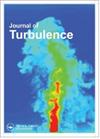湍流结构对带有三角形粗糙度单元的Rayleigh–Bénard对流换热的影响
IF 1.5
4区 工程技术
Q3 MECHANICS
引用次数: 0
摘要
一个公认的结论是,壁面粗糙度并不总是能增强湍流热对流的热传输。本文从湍流结构的角度对传热效率进行了统计研究。采用格子Boltzmann方法数值模拟了湍流结构对带有三角形粗糙单元的Rayleigh–Bénard对流传热的影响。我们使用聚类方法来识别与强烈事件相关的复杂湍流结构。对于小的粗糙度高度H/L,Nusselt数减小,而对于大的H/L,热传输增强。对于大的H/L情况,占据负传热事件的正温度结构降低了传热效率。相反,负温度湍流结构促进了热传递。通过对条件平均场的分析,我们发现大H/L情况下传热的增强是由于负温度结构起主导作用。对于小的H/L情况,正温度结构抑制了热传递。此外,对于大的H/L情况,在实心壁和盒子的角落附近产生了更多的正温度结构和负温度结构。Nu增强的物理解释是,这些湍流结构和粗糙壁的相互作用产生了更多的二次涡流,导致更多的羽流从边界层喷射到主体。本文章由计算机程序翻译,如有差异,请以英文原文为准。
Influence of turbulent structure on the heat transfer of Rayleigh–Bénard convection with triangular roughness element
ABSTRACT There is a widely accepted conclusion that the wall roughness do not always enhance the heat transport of the turbulent thermal convection. In this paper, the heat transfer efficiency is statistically investigated from the perspective of turbulent structure. The effect of turbulent structure on the heat transfer of Rayleigh–Bénard convection with triangular rough element on the top and bottom plates is numerically simulated by a lattice Boltzmann method. We use a clustering method to identify complex turbulent structures associated with intense events. The reduction of the Nusselt number is obtained for small roughness height H/L, while the enhancement of heat transport appears for large H/L. For the large H/L case, the positive temperature structures occupying the negative heat transfer events reduce the efficiency of the heat transfer. On the contrary, the negative temperature turbulent structures boost the heat transfer. By analyzing the conditional average field, we found that the enhancement of the heat transfer for large H/L cases is due to that the negative temperature structures play a dominant role. For small H/L cases, the positive temperature structures inhibit the heat transfer. Furthermore, the more positive and negative temperature structures for large H/L cases are generated near the solid wall and the corner of the box. The physical explanation for the Nu enhancement is that the more secondary vortices are generated by the interaction of these turbulent structures and the rough wall, leading to more plumes ejected from the boundary layers to the bulk.
求助全文
通过发布文献求助,成功后即可免费获取论文全文。
去求助
来源期刊

Journal of Turbulence
物理-力学
CiteScore
3.90
自引率
5.30%
发文量
23
审稿时长
6-12 weeks
期刊介绍:
Turbulence is a physical phenomenon occurring in most fluid flows, and is a major research topic at the cutting edge of science and technology. Journal of Turbulence ( JoT) is a digital forum for disseminating new theoretical, numerical and experimental knowledge aimed at understanding, predicting and controlling fluid turbulence.
JoT provides a common venue for communicating advances of fundamental and applied character across the many disciplines in which turbulence plays a vital role. Examples include turbulence arising in engineering fluid dynamics (aerodynamics and hydrodynamics, particulate and multi-phase flows, acoustics, hydraulics, combustion, aeroelasticity, transitional flows, turbo-machinery, heat transfer), geophysical fluid dynamics (environmental flows, oceanography, meteorology), in physics (magnetohydrodynamics and fusion, astrophysics, cryogenic and quantum fluids), and mathematics (turbulence from PDE’s, model systems). The multimedia capabilities offered by this electronic journal (including free colour images and video movies), provide a unique opportunity for disseminating turbulence research in visually impressive ways.
 求助内容:
求助内容: 应助结果提醒方式:
应助结果提醒方式:


